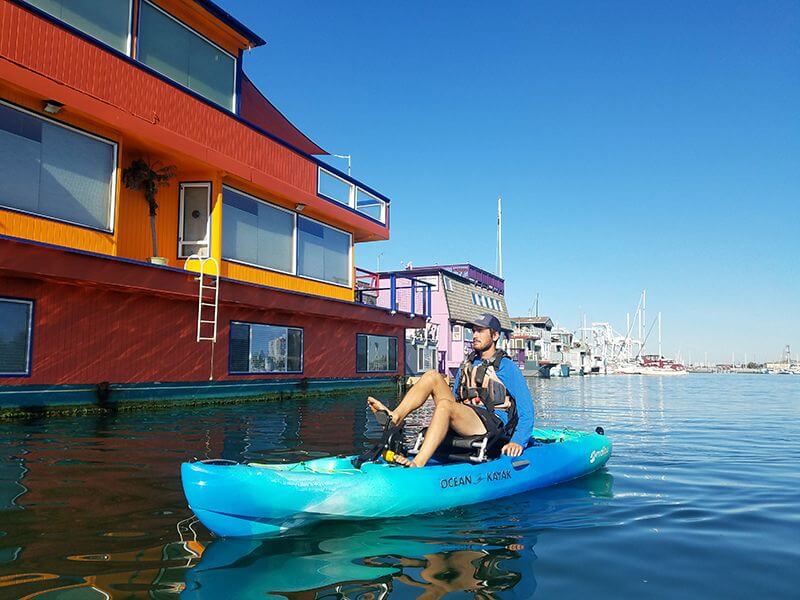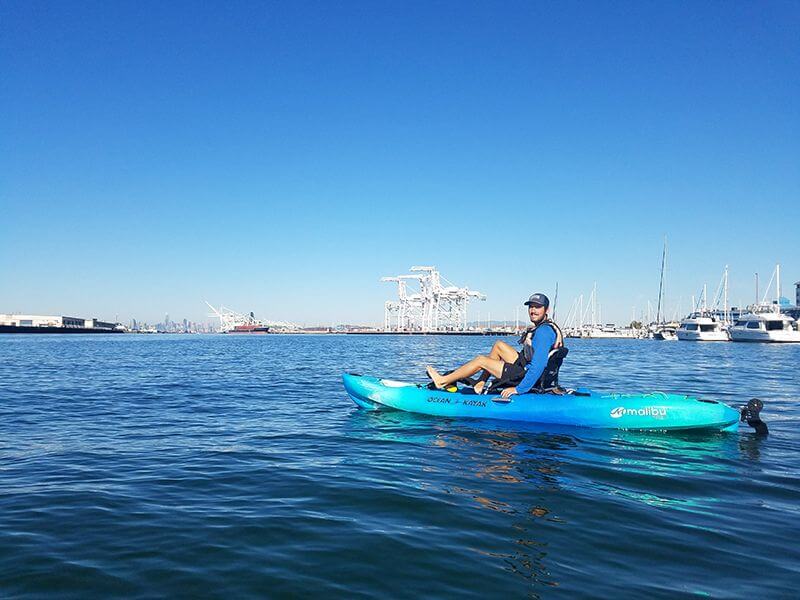Malibu Pedal Performance Test
By: Byron Roos, Ventura-based Kayak and Raft Guide at Kern River Outfitters
About the Review Location
Kayak performance reviews are best done on challenging waters. That said, I recently reviewed the new Ocean Kayak Malibu Pedal in the waters around Channel Islands National Park in Southern California. Specifically, I chose the unique paddling conditions around the volcanic formation of Santa Cruz Island.
Consider that hundreds of sea caves line the base of sea cliffs that form the perimeter of the island; its "beaches" are mounds of football-sized boulders, fallen from cliffs, and shaped by the ocean; and immediate offshore waters are kelp-filled much of the year. It's a paddling environment that should be largely inhospitable to a pedal-powered kayak with a submerged propeller. Rocky launches and landings-combined with numerous water obstacles-threaten to damage the propeller or reduce its efficiency. Thus, it was on this island that I wanted to put my Ocean Kayak Malibu Pedal to its first big test. What follows are my findings on the Malibu Pedal's performance through a multi-day kayak adventure in difficult, real-world conditions.

Weight/Transportation
Loading and securing the Malibu Pedal on my vehicle was a breeze. Although heavier than most standard single kayaks (approx. 100 lbs./45.4 kg.), the weight and volume contribute greatly to the 12-foot Malibu Pedal's impressive stability. Solid bow and stern handles make carrying the kayak simple with two people. Even solo, it's quite manageable. The Malibu Pedal's comfortable Element Bench Seat (EBS) and PDL Drive System are quickly removed for transport, reducing total weight by nearly 20 pounds. Handles at the port and starboard midpoint of the Malibu Pedal offer very solid attachment points for securing the kayak to the roof rack of a vehicle. Overall, the Malibu Pedal is very easy to transport despite its size, thanks to the detachable components and multiple carrying and attachment points.
Launching
Given Santa Cruz Island's rocky beach, mid-sized shore break and fast period, launching the Malibu Pedal was my biggest initial concern. Although the kayak's design allows both the PDL Drive propeller system and rudder to be in a lifted position for launching, I was concerned that the PDL Drive's propeller would rattle loose from its retracted position while launching into violent, breaking waves. Thankfully, the solidity of the design held up during each of my launches. The PDL Drive remained retracted through contact with several breaking waves on to the way to open water. Given the high volume of the Malibu Pedal, entering the kayak in knee-deep water is very stable despite the seat being raised more than most kayaks. Using a spare paddle to get the Malibu Pedal through the breakers is easy if you are concerned about lowering the propeller. Once in open water, it took only twenty seconds to stow a spare paddle, lower and lock the PDL Drive, and drop the rudder. If you are launching the Malibu Pedal off a dock in calm water, it could not be easier. Simply sit down, pedal, and go!
Performance: Comfort, Speed and Agility
I was immediately impressed with the Malibu Pedal's comfort and speed. The kayak is supremely comfortable. The Element Bench Seat (EBS) is easily adjusted to the desired level of reclination and fore/aft adjustment to accommodate all leg lengths. Two cup holders fall within easy reach. The rudder control fits comfortably into your right hand, and it is simple to use even while the seat is quite reclined. The textured pedals add grip for easy barefoot pedaling without the risk of your feet slipping.
The Malibu Pedal's speed is remarkable. In a reclined position with a beverage in one hand, and rudder control in the other, it's simple to match the pace of friends paddling alongside. It's the PDL Drive system's efficiency that makes the Malibu Pedal suitable for longer adventures. With moderate effort, it was easy to sustain a pace of four miles per hour for an extended time. If a situation necessitates speed, the Malibu Pedal can reach up to five and a half miles per hour. The efficient 10.3:1 gear ratio converts even modest pedaling into impressive speeds.
The Malibu Pedal is very agile, which does take time to get used to. The rudder system is very efficient and allows for quick turns in open water. Backpedaling brakes the kayak's momentum rapidly and then puts the kayak into reverse. Although the Malibu Pedal does not move in reverse as quickly as it moves forward, it is still quite speedy going backwards. The backpedal feature makes avoiding rocks and keeping distance from wildlife and other hazards quite straightforward. This feature proved crucial while paddling Santa Cruz Island. That said, the kayak's wide beam (34.5"/87.6 cm) can make tight squeezes between rocks challenging to negotiate at first. Thankfully, the large volume of the Malibu Pedal also adds impressive stability, so bumps and leans while getting used to the size of the kayak are unlikely to lead to capsizes.

Interior Storage
Some of the best features of the Malibu Pedal stem from its storage capabilities. In addition to standard stern and bow bungee storage areas, the Malibu Pedal has large volume interior storage. Under the seat, there is a hatch that extends to a large, watertight mid-hull storage area, which easily accommodated my multi-day camping gear. One drawback is that this storage is not particularly accessible while on the water, but that is not a large concern if the kayak is packed properly. My favorite storage feature, however, is the small storage hatch on top of the PDL Drive. Within easy arm's reach, this watertight storage space can hold cameras, snacks, phones, or other items that don't do well in PFDs or beside your seat. Overall, the Malibu Pedal has a versatile storage system to accommodate single day trips and extended adventures.
Pedaling Through Kelp
Kelp was the most consistent obstacle I faced while testing the Malibu Pedal on Santa Cruz Island. If the Malibu Pedal passes over kelp while the propeller is spinning, kelp can wrap around the propeller and bring it to a standstill. Losing momentum is frustrating, but the Malibu Pedal design makes avoiding or quickly solving the problem simple. It is possible to pass over kelp quite easily if you gather momentum and cease pedaling right before you reach kelp stalks. When the pedals are not engaged, the propeller does not spin, and does not wrap with vegetation. In areas of particularly thick kelp, it may be necessary to lift the PDL Drive and switch over to paddling. In the event of getting the propeller stuck in kelp, it takes approximately 10-15 seconds to lift the propeller, clear the kelp off of it, and lower it into locked position. Another option is to keep the PDL drive deployed and pedal quickly backward and forward to loosen and shed the debris.
Landing
Landing the Malibu Pedal is simple. The PDL Drive's design allows you to set up for landing and final approach with precision. Lifting the PDL Drive and rudder out of the water is easy, via integrated PDL drive handle and kickstand and starboard rudder lever. After that, the landing is similar to the stability of landing a double kayak. Depending on the type of beach you're landing at, getting the kayak onto the shore by yourself can be challenging. On sand beaches, dragging the kayak out of the surf is manageable by yourself, and easy with a friend.
Conclusion
Overall, the Malibu Pedal is a versatile kayak suitable for relaxing pedals on a lake or multi-day ocean adventures in challenging waters. The comfort, speed and agility of the Malibu Pedal are far beyond that of traditional sit on top kayaks. The design and functionality of the kayak shines from loading the kayak onto a car to landing it in surf. Pedal on!
For tips on selecting the right pedal kayak see our buying guide.






